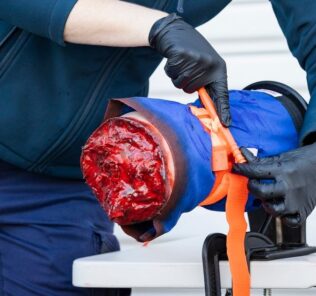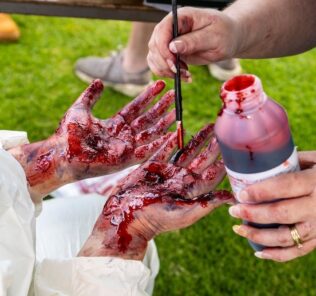July 4th Fireworks Burn Moulage for Trauma Training
Trauma Simulation can provide instruction on how to perform skills that can be pivotal in avoiding medical emergencies. During the holiday season and specifically on Independence Day in the United States, fireworks can pose a serious risk if mistakes or errors in judgment are made. Fireworks are a major cause of emergency department visits due to injuries during the July 4th celebrations. According to the United States Consumer Product Safety Commission Fireworks Injuries and Death 2023 Report, approximately 1500 injuries were related to fireworks. Of these injuries, 66% occurred in the weeks before and after the July 4th holiday. To help avoid these outcomes, this HealthySimulation.com article serves as a public service announcement and shares tips and resources to mitigate risk – and for those in the United States, HAPPY JULY 4TH!
Fireworks Injuries Distribution
Of the 1500 injuries from fireworks, 800 were fireworks injuries, and 700 were sparkler injuries. Approximately 42% of all the fireworks injuries were burns. In 2023, there were 9,700 people treated in Emergency Departments for fireworks injuries. Eight deaths from fireworks occurred in 2023. In 2023, approximately 18% of selected and tested fireworks products were found to contain non-compliant components, including fuse violations, the presence of prohibited chemicals, and pyrotechnic materials overload.
Sponsored Content:
It is important to remember that injuries occur with sparklers due to the intense heat produced. Sparklers burn at about 2,000 degrees Fahrenheit—hot enough to melt some metals. Many adults allow children to use sparklers without recognizing the risk of injury that can occur. Teenagers 15 to 19 years old had the highest estimated rate of emergency department-treated fireworks-related injuries. Children 5-9 years old have the second highest rate.
The most injured body parts for burns are:
- Legs 8%
- Trunk/Other 11%
- Eyes 19%
- Head, Face, and Ears 22%
- Hands and Fingers 35%
Safety Tips for July 4th
The US Consumer Product Safety Commission suggests some safety tips;
Sponsored Content:
- Never allow children to play with or ignite fireworks, including sparklers
- Make sure fireworks are legal in your area before buying and using them
- Keep a bucket of water or a garden hose handy in case of fire or other mishap
- Light fireworks one at a time, then move back quickly
- Never try to re-light or pick up fireworks that have not ignited fully
- Never use fireworks while impaired by alcohol or drugs
- Never point, aim, or throw fireworks at anyone
View the LEARN CE/CME Platform Webinar Ouch! An Introduction on How to Create to learn more!
Simulate for Safety’s Sake
The question is how can simulation help train our healthcare providers to treat the rise in fireworks injuries during the July 4th Holiday.
- Just-in-time training before the holidays
- In Situ
- Onboarding new employees
- Annual training skills
According to Sarmasoglu and colleagues, moulage effectively increases healthcare professionals’ engagement in simulation, realism, and learning. Burn treatment is one of the most used methods of moulage incorporation into simulation scenarios. The color, depth, tissue, and surface area help the learner to assess and diagnose the burn depth and cause of injury. When realistically created, these are critical factors for the learners to develop and implement evidence-based treatment and management of burns.
More About Trauma Moulage
Moulage is a unique technique within the field of Healthcare Simulation that pairs artistry with medical accuracy so that healthcare learners can have the highest level of realism when treating simulated patients. Moulage can help learners suspend their imaginations and experience the vast array of emotions that can come with providing emergency care while practicing how to exert calm and confidence and maintain control of any medical scenario. Simulated injuries made possible by Moulage can provide added value to training sessions for emergency response teams, military personnel, and healthcare learner programs. Healthcare professionals who focus on education and training via Clinical Simulation methodologies should be familiar with various Moulage concepts and techniques and how they can elevate any learning experience.
The level of realism presented by Moulage products is shocking, but is necessary to train Healthcare Simulation learners about what to expect in real-life situations. For example, when a person first sees a painful, distracting injury on another human being, their response can be one of dread, anxiety, or fear. However, through repeated exposures to injuries or patient presentations, Medical Simulation with Moulage can make jarring injuries less startling when encountered in real clinical scenarios.
Moulage Materials Needed
Based on the type and level of the burn, the simulation personnel must realistically create the burns to allow the learners to make the connection between assessment and treatment. One must remember to build in layers to create realistic depth. Here is a list of moulage materials needed to develop realistic burns:
- Gelatin powder (color depending on scenario)
- Liquid glycerin
- Water
- White, brown, green, and black nail polish
- Dr. Oetker gel coloring agent red 10 G
- Tongue depressor
- Makeup brushes of various sizes
- Pink, red, purple, and white lipstick
- Paper towels
- Chocolate sauce
- Liquid latex solution
- Multiple colors of eye make-up and rouge
- Sponge make-up and brush applicators
- Red food coloring
- Toothpicks
- Spray bottle
- Burnt clothing
- Lotion
- Caro syrup
- Baking powder
- Oatmeal
- Rice
- Petroleum Jelly
- Purchased burn overlays
- More depending on your imagination
Watch These Videos for Moulage Ideas
Enroll in the LEARN CE/CME Platform Course TraumaSIM’s Introduction to Moulage Online Course for more in-depth learning!
Learn About Moulage – Resources, Kits, Recipes & More!
References:
- Sarmasoglu, S., Celik, N., Elcin, M., & Senel, E. (2020). Pediatric severe burn moulage: Recipe and evaluation from the burn team.Clinical Simulation in Nursing 49, 32-39.
Teresa Gore, PhD, DNP, APRN, FNP-BC, CHSE-A, FSSH, FAAN – Dr. Gore has experience in educating future nurses in the undergraduate and graduate nursing programs. Dr. Gore has a PhD in Adult Education, a DNP as a family nurse practitioner, and a certificate in Simulation Education. Dr. Gore is an innovative, compassionate educator and an expert in the field of healthcare simulation. In 2007l Teresa started her journey in healthcare simulation. She is involved in INACSL and SSH. She is a Past-President of INACSL and is a Certified Healthcare Simulation Educator Advanced (CHSE-A). In 2018, she was inducted as a Fellow in the American Academy of Nursing (FAAN). In 2021, she was inducted as a Fellow in the Society of Simulation in Healthcare Academy (FSSH) and selected as a Visionary Leader University of Alabama at Birmingham School of Nursing Alumni. During her career, Dr. Gore has led in the development and integration of simulation into all undergraduate clinical courses and started an OSCE program for APRN students. Her research interests and scholarly work focus on simulation, online course development and faculty development. She has numerous invited presentations nationally and internationally on simulation topics.
Sponsored Content:




















